Fun Facts About Sharks – Printable Fact Cards
Table of Contents
If you’re looking for a fun way to teach kids all about ocean creatures like the great white, check out our collection of free printable posters of fun facts about sharks! We’ve got posters for all your favourite shark species, from the tiger shark to the whale shark, with each poster featuring interesting family-friendly facts and neat cartoon images of sharks.
Whether you’re a teacher looking for a fun educational activity or a parent trying to find DIY kids’ activities at home, these free printable PDFs are perfect for games, learning, and more. They’re especially perfect for creating shark-themed activities during Shark Week, or simply as fun facts and entertainment for kids who love sharks!
There are also lots of movies featuring sharks, making these free shark cliparts a great way to help kids recognise them in the future. Spotting shark species or other animals in family-friendly movies is a fun way to bond while you watch, and an even better way of testing your kids’ shark knowledge, image recognition, or memory, all while making movies an educational experience.
Fun Facts About Sharks for Kids (Top 10 Sharks)
So, what’s included with our printable fun facts about sharks? You’ll find ten free-to-download posters that can be printed off for classrooms, kids’ bedroom decorations, activities, or even lessons! If you’re a parent who’s homeschooling, these fact posters are a great way to teach kids about sharks and other ocean life.
With our vibrant clipart of sharks, you’ll also be able to show them what different species of sharks look like and how they use their distinct features under the water. You might also get a laugh out of some species like the goblin shark, since it has a pretty funny face! Don’t worry, our posters include cute shark pictures with a cartoonish style to show what kind of features they have, and prove that sharks aren’t so scary!
Not only are these free worksheets great for learning about sharks and the ocean, but they can be used for trivia, memory games, and other imaginative activities. For example, you can test your kids’ knowledge or memory and fact-check via our posters, or see if they can match the facts to the correct shark! All poster facts are provided in clear speech bubbles so that they can be easily cut out, along with each shark image.
Matching games are an excellent way to keep the kids entertained while testing their shark knowledge and memory. You could also have them try roleplaying with sharks by using the facts to build characters. Storytelling is a great way to improve their creativity and imagination, all while teaching useful facts for kids about sharks.
With so many free DIY activity options, you can boost your kids’ memory skills, image recognition, and cognitive thinking. They’ll also have lots of fun facts to share with their friends or at school!
Fun Facts About Great White Sharks
As one of the top ocean predators, there are a lot of cool facts about great white sharks, and they’re likely to be one kids will easily recognise. You might know the quote “fish are friends, not food”, which is said by Bruce, a great white shark in Finding Nemo! Bruce is easily one of the most recognisable great whites, and is designed to be loveable and cartoonish to show that sharks could be friends (and not food!). Bruce also has two shark friends of different species – Could your kids recognise which ones they are?
Our educational posters have a few of our favourite great white shark facts, but we’ve got plenty more to learn.
- Great white sharks can grow up to around 20ft long! That’s about the size of two cars, but male great whites are smaller than females and often only around 11-13ft long. While they don’t reach full size until they’re 15 years old, they can live to over 70!
- They have around 300 razor-sharp teeth that are arranged in multiple rows – Some great whites have as many as seven rows of teeth! They also lose and regrow their teeth all the time, growing new teeth in as little as a day.
- The great white shark can swim up to 35 miles per hour, especially in short bursts while attacking prey.
- Although they’re an apex predator that can eat lots of sea creatures, their favourite food tends to be seals, sea lions, and other large fish. As a big shark, it’s no surprise they have an even bigger appetite!
- They have a super strong sense of smell and can smell blood from up to three miles away, even if it’s just a drop. But don’t worry, they don’t like the taste of humans!
- Great whites are one of a few sea creatures that can be found in all major oceans. They prefer cooler temperatures and typically inhabit coasts.
- While most sharks are cold-blooded, great whites have warmer blood to help them hunt in cool, coastal water.
- Like other young sharks, baby great white sharks are called pups, and a mother can have 2-10 pups in one go! Can you imagine being born with 9 siblings? That isn’t even the most pups a shark can have! Check out the other shark species to learn more.
- They can jump up to 10 feet out of water to catch their prey – This type of jumping is called breaching!

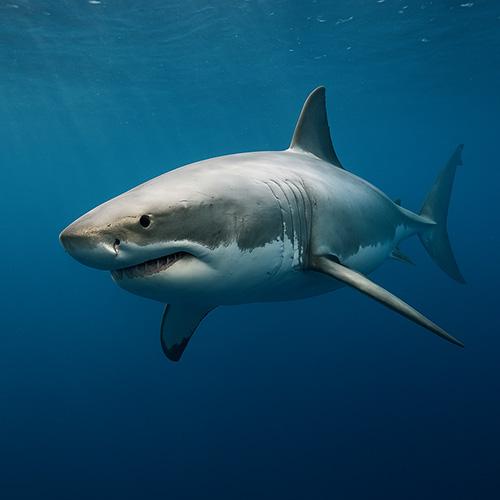
Fun Facts About Hammerhead Sharks
Besides the great white, these are easily one of the most recognisable sharks and we have plenty of fun facts about hammerhead sharks to go with your printable shark card. The kids are sure to recognise a hammerhead shark, especially since a shark that looks like a hammer is kind of funny! There’s a lot more to explore about hammerheads though, including how they make use of their wide, hammer-like heads and distant eyes.
- Since their eyes are on the sides of their heads, hammerhead sharks have excellent vision that almost spans 360 degrees. That means that even if you’re behind one, they can still see you!
- Their wide, hammer-shaped head is called a cephalofoil. Alongside their excellent vision helping them spot prey, they use their wide heads to pin their prey to the ocean floor.
- Their favourite food is stingrays, though they also like squids and other small fish! Hammerheads have very keen senses and can spot stingrays even if they’re under the sand.
- There are nine different species of hammerhead sharks! The biggest is the great hammerhead, which can grow up to 20ft long – Similar to a great white shark.
- Although sharks are normally solitary hunters, hammerheads are known to occasionally swim around in groups. These groups are called schools or shivers! Scalloped hammerheads can form schools of up to 500 sharks – That’s a lot!
- Like most other cold-blooded creatures, including sharks, hammerheads prefer warm, tropical waters and will typically live near warm coasts.
- They aren’t actually born with their hammer heads – Hammerhead pups have soft, round heads that harden and flatten as they get older. Their heads help them swim by moving side to side, helping them turn more quickly than other sharks. They’re also the only shark that sometimes swims sideways!
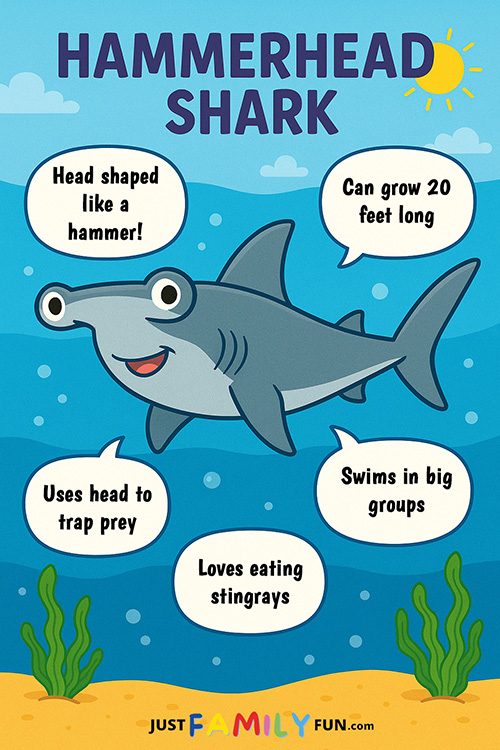

Fun Facts About Tiger Sharks
There are lots of interesting facts about tiger sharks to learn, including that they got their name from the stripes on their skin! These stripes actually start as dark spots that turn into lighter stripes that help them stay camouflaged underwater.. Check out some more neat tiger shark information below!
- While they’re known as tiger sharks because of their cool stripes, they’re also known as the garbage can of the ocean since they’ll eat pretty much anything! Tiger sharks are often found with items like tires and license plates in their stomachs – One was even found with a chicken coop, and another with a full suit of armour!
- Unlike the sharp, pointed teeth that most sharks have, tiger sharks have L-shaped teeth that help them bite through tough objects like turtle shells.
- They can grow up to 16 feet in length and can weigh up to 1400 pounds, making them the size of about eight humans combined!
- While some sharks lay eggs, tiger sharks give birth to live pups and can have up to 80 at a time, although the average is 30-40. Tiger shark pups are also pretty big! They’re born at around 20-30 inches long, which is about the size of a skateboard.
- On theme with being the garbage cans of the sea, tiger sharks are the only shark species known to regularly eat birds resting on the water.
- Tiger sharks have great night vision, almost like built-in night goggles! They can also detect tiny vibrations in the water from far distances, making them excellent hunters.
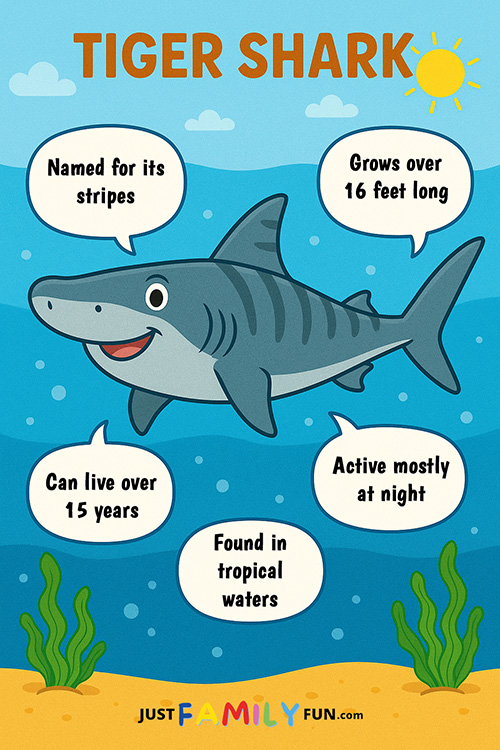

Fun Facts About Whale Sharks
Alongside other cool facts about whale sharks, you might have spotted these guys in movies too! Do you know who the whale shark is in Finding Dory? Don’t worry if not, you’ll learn plenty about the whale shark here and how to spot them in the future.
- Despite being a shark (not a whale!), whale sharks are the biggest fish in the world. They can grow up to 60 feet long, though they’re typically around 40ft, which is still even longer than a school bus!
- They might seem scary due to their size, but whale sharks are actually incredibly friendly and known as gentle giants. They’re completely harmless towards humans and prefer to eat small creatures like plankton.
- Whale sharks live incredibly long compared to a lot of other sharks. They have a lifespan of 80-130 years!
- As part of their gentle giant vibe, whale sharks are pretty slow and like to cruise around tropical oceans at around 3 miles per hour. You could probably run faster than that!
- Although they prefer to eat small creatures, their wide mouths make it difficult to avoid other elements. Their mouths can be up to 5 feet wide (which is longer than most adults’ height!) and they swallow around 1500 gallons of water every hour. That’s the equivalent of drinking 24 bathtubs of water in an hour!
- Since a lot gets caught in their mouths, whale sharks have special pads in their mouths that act like filters for their food.
- Whale sharks can be recognised by their white spots and stripes, which are unique to every whale shark – Kind of like how humans all have different fingerprints!
- They can dive over 6,000 feet deep and sometimes stand vertically underwater to eat – This is called bottling!
- They can weigh as much as four elephants and their skin is much thicker!


Fun Facts About Goblin Sharks
You might not have heard many facts about goblin sharks, but you’re sure to recognise these funny little guys moving forward. It’s unsurprising that they got their name from their interesting pointy snouts, but there are other creepy facts about goblin sharks that might have contributed too!
- Their long, flat snout is called a rostrum! They can use it to shoot their jaws forward quickly and snatch up prey, which is called slingshot feeding. They can shoot their jaw out like a catapult quicker than you can blink!
- Goblin sharks live in deep ocean water, far beneath where sunlight can reach. That’s about 900-4300 feet deep!
- They’re also sometimes known as alien sharks because of their odd appearance. Scientists also refer to them as a living fossil since they haven’t evolved or changed in over 100 million years.
- Goblin sharks evolved during the early Cretaceous period, while dinosaurs went extinct in the late Cretaceous period. That means that goblin sharks lived alongside the dinosaurs for quite some time! Do you think that’s why they have such a peculiar appearance?
- They’re one of the rarest sharks and are hardly ever seen by humans, probably because they live so deep underwater!
- Although they can snap up prey pretty easily with their long jaws, goblin sharks are kind of lazy and will cruise along deep ocean water at slow speeds to conserve energy.
- Goblin sharks aren’t pink but often appear this way due to blood vessels under their skin.
- Their snouts can detect electrical fields, which makes them work kind of like a metaldetector for food. They can detect their prey easily in the darkness and often eat squid, fish, or other deep-sea creatures. They’re also able to detect heartbeats, but their eyes are pretty small since it’s so dark down there anyway!
- They were first discovered in Japan and became known there as tenguzame as they believed it was similar to mythical creatures named tengu!
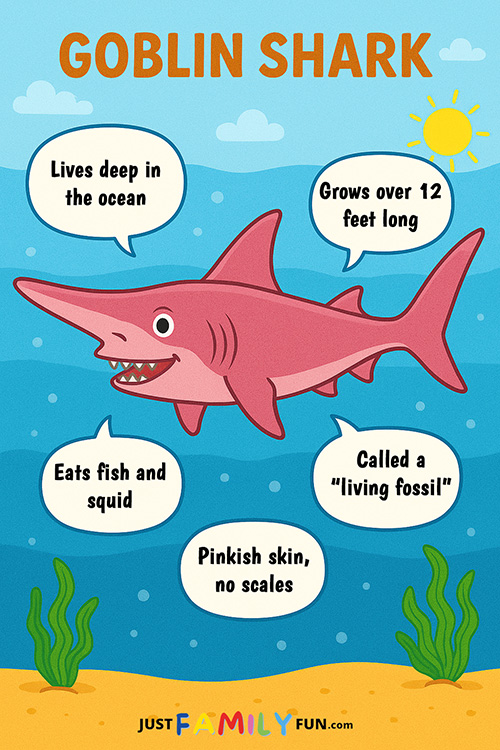
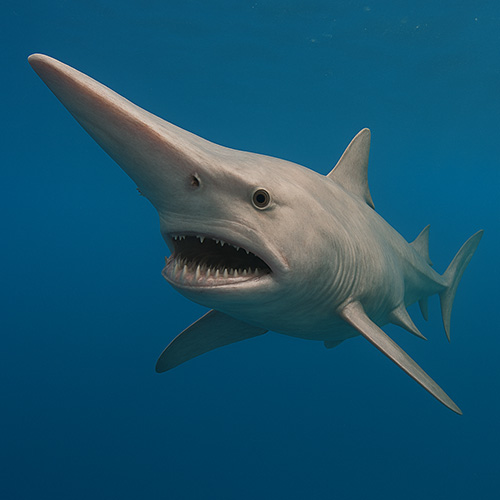
Fun Facts About Nurse Sharks
There are lots of cool facts to learn about the nurse shark, which is a lesser-known species that hangs out in warm, shallow coasts. Although they’re not highly represented in media, nurse sharks have some pretty cool features.
- Similar to whale sharks, nurse sharks are pretty docile and will often let divers swim near them – That makes them a great shark to capture footage of!
- Nurse sharks are bottom-dwellers, meaning they like to stay near the sea floor in shallow water. They often rest in caves or under rocks on the ocean floor, and will even sleep with other sharks! Sometimes, there can be as many as 40 nurse sharks sleeping together in a big pile.
- Unlike sharks with sharp, pointed teeth, nurse sharks have small, flat teeth that are better for crushing than ripping. Since they live so close to the sea floor, these tiny teeth are perfect for crushing shells that they might scoop up!
- They have whiskers near their mouths that help them feel around and find prey, kind of like catfish! These whiskers are called barbels.
- They don’t live quite as long as some other sharks but can reach 14 feet long and live over 30 years.
- Most sharks can’t breathe while staying still and need to keep swimming even while they’re asleep. The nurse shark is one of very few that can breathe while sitting still, which is called buccal pumping.
- Although they look smooth, sharks often have rough, scaly skin that can feel sharp as razors. Contributing to their docile nature, nurse sharks have smooth skin that feels a little more like sandpaper! It still might not be great to stroke, but it’s certainly nicer than others.
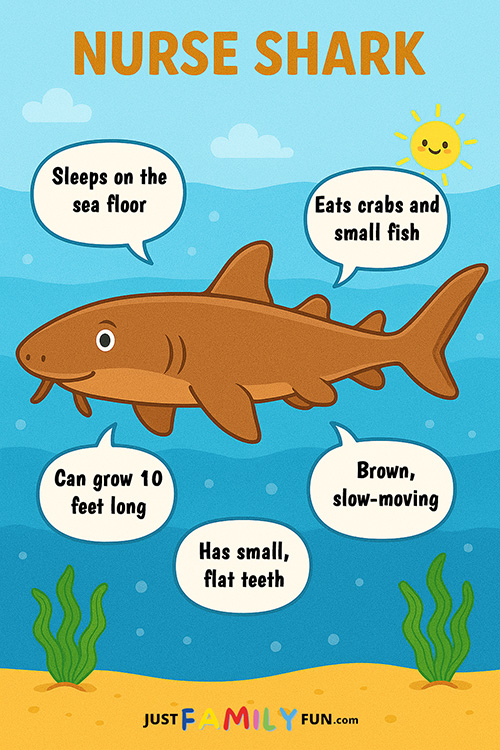
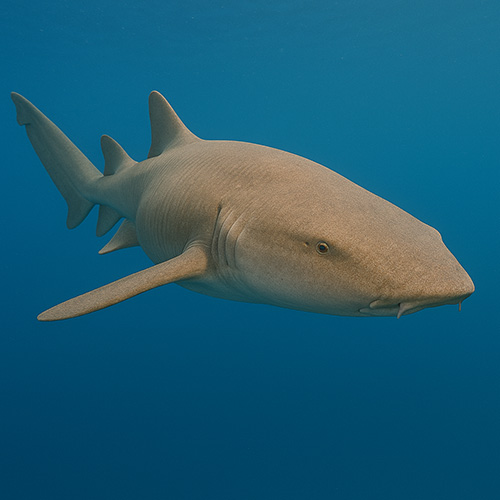
Fun Facts About Thresher Sharks
We’ve got plenty of neat facts about thresher sharks too, which are especially common in video games that you might have played! They’re often portrayed as predators similar to the goblin shark, but they’re actually harmless towards humans and have lots of interesting qualities.
They’re very shy and will avoid making contact with humans wherever possible!
They live in the deep sea, like goblin sharks, and feed on similar food like squids, fish, and crustaceans.
They can grow up to 20 feet in length, but their tail makes up around half of this! They have super long tails that they use to whip fish and stun them before eating. Their tail can move at 80 miles an hour, which is faster than a cheetah can run! It can also produce a sonic boom underwater, knocking fish unconscious.
Although they live deep down in the ocean, they’re known to come to the surface and jump up out of the water, even doing full flips sometimes. Do you know what that’s called?
While they have relatively small mouths and heads, they have massive eyes that provide great vision for them. They can also heat their brain and eyes to help them see better in colder water!
Since it’s pretty tricky to clean yourself in the ocean, thresher sharks will find small fish to nibble dirt and parasites off of them, which is very rare behaviour!
In ancient greece, threshers were known as alopias, which means fox sharks! They called them this as they thought they were very cunning hunters, like a fox is!
There are three kinds of thresher sharks; common, bigeye, and pelagic. Unsurprisingly, the bigeye thresher shark has the biggest eyes, which are the same size as tennis balls.

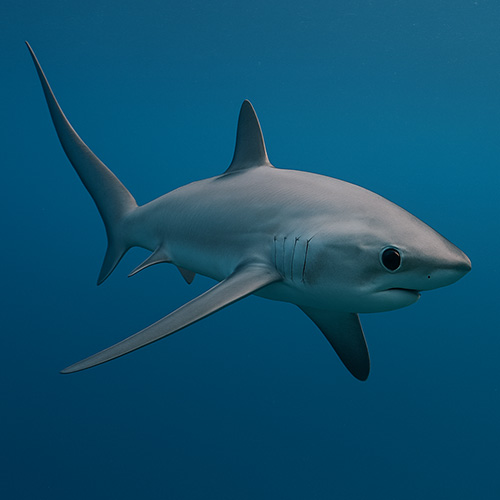
Fun Facts About Greenland Sharks
Although they may be another lesser-known species of shark, there are still interesting facts to learn about greenland sharks. As you might guess, their name comes from the country of Greenland as they prefer to live in the Arctic and North Atlantic!
They live in the coldest waters of any shark, and can live to over 500 years old. It’s surprising they aren’t more well-known, since they live so long! A greenland shark living today could have possibly been alive at the same time as Shakespeare.
Though they like eating fish and squid, they’re also known to eat carrion, which is dead animals found in the ocean.
Since they don’t clean themselves off like thresher sharks, most greenland sharks have parasites covering their eyes and making them nearly blind.
While they might struggle to see, they’re incredibly silent movers and are able to stealthily sneak up on their prey. It’s probably a good thing they can sneak up close, since they move slower than 1 mile per hour!
They have tiny, sharp teeth that are great for gripping onto prey and stopping it from getting away.
Greenland sharks grow to around 24 feet long and can weigh 2000 pounds, which is as heavy as eight refrigerators!
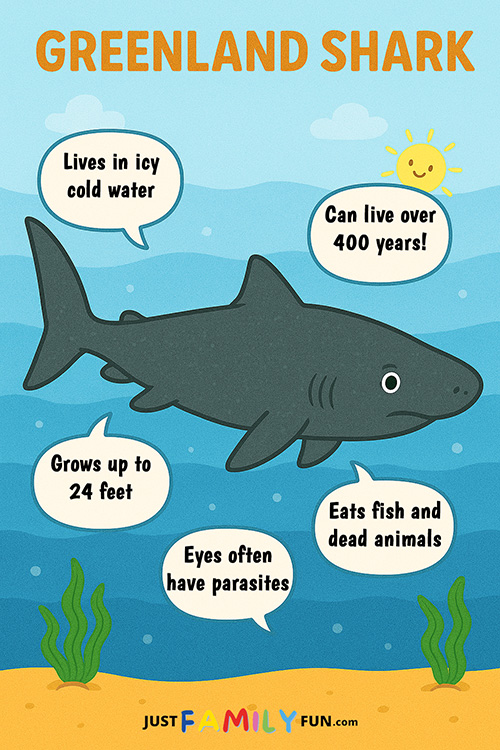
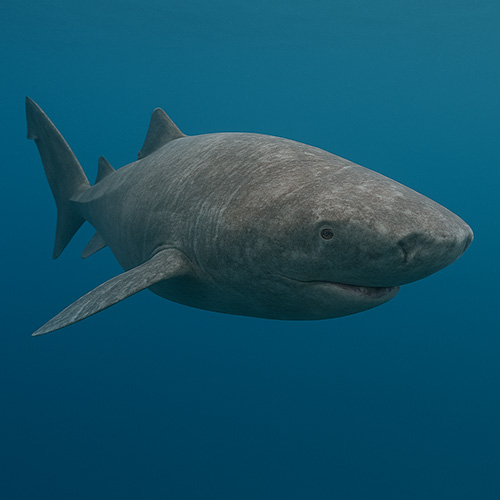
Fun Facts About Basking Sharks
They might be another less famous shark compared to beasts like the great white, but basking sharks are still one of the most well-known, and we have some interesting facts to share about them.
Growing up to 40 feet long, basking sharks are the second-largest shark after whale sharks. That’s a bit longer than a double-decker bus, though most basking sharks are between 26 and 32 feet long.- Although they’re big enough to eat other sea creatures, basking sharks prefer to eat small creatures and plankton, similar to the whale shark’s diet. They also swim with their mouth open to catch and filter food from the water.
- Basking sharks have huge sets of gills that almost wrap around their entire head! These five big gill sets help them filter water by catching food in their mouths and releasing water out through the other side. They filter around 2000 tons of water per hour!
- While most sharks prefer warm waters, the basking shark likes to live in cooler oceans and can be found all over the world.
- Despite their huge size, they have small throats and aren’t able to eat big food, which is part of why they focus on plankton and other small creatures. In fact, they can’t swallow anything bigger than a cherry tomato!


Fun Facts About Mako Sharks
Saving possibly one of the best to last, here are some fun facts about the mako shark! While these guys unfortunately joined the list of endangered species not too long ago, they’re still a pretty popular shark and for good reason.
- Makos are the fastest sharks in the world, swimming at around 45 miles per hour and able to burst forward at 60 miles per hour. Part of why they’re so fast is because their bodies are streamlined like torpedos, helping them glide through water quickly!
- They’re known for jumping extra high out of the water, reaching up to 30 feet – That’s like jumping as high as two cars lined up next to each other.
- Their teeth are thin and sharp like other sharks, but they’re also curved to help them keep their grip on slippery fish.
- While most sharks have particular diets like squids or fish, the mako shark eats swordfish as well! They’re quite the predator, especially since they can catch up quickly.
- Since they live and hunt in deep water where there’s no light, they have huge eyes that help them see better.
- They can grow up to 13 feet long and can weigh over 1000 pounds. It might sound like a lot, but it’s actually pretty small compared to other sharks, which helps it maintain its speed and build up quickly.
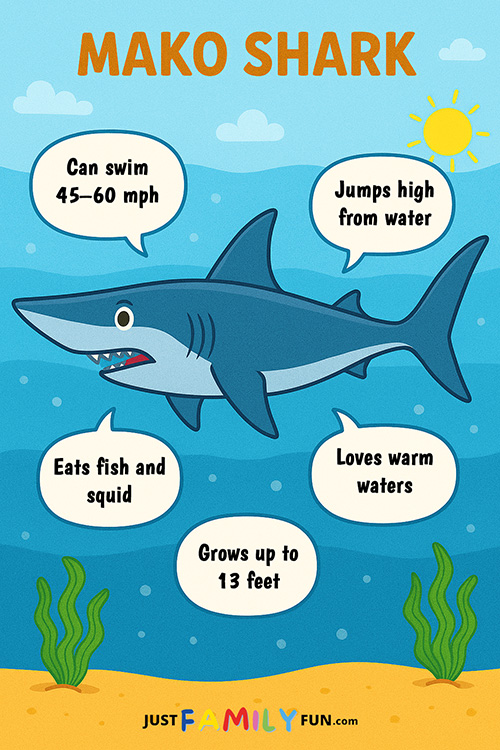
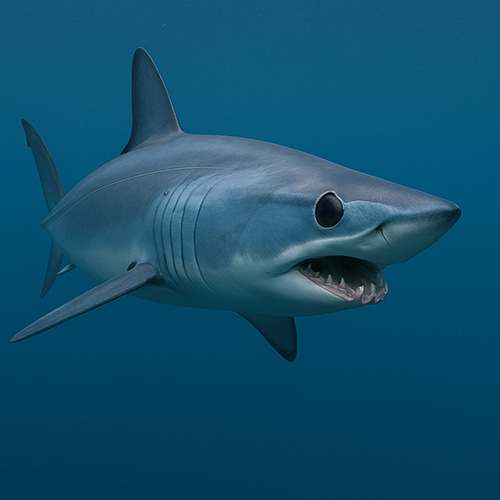
Weird Fun Facts About Sharks and Interesting Shark Trivia
- Sharks are one of the oldest known creatures still living, and are even older than trees! They’ve been around for over 450 million years, which is also long before the dinosaurs existed.
- Some sharks can get a tan! Their skin darkens if they spend enough time in the sun, though deep water sharks may not see the sun often enough.
- Sharks can lose up to 35,000 teeth throughout their lifetime, since they quickly grow back in rows – Kind of like a conveyor belt of teeth!
- Since they’ve been around for so long, sharks have seen lots of events and have survived five mass extinctions. If only the dinosaurs could have done the same!
- Even though they have skeletons, sharks don’t have any bones. Their skeletons are made up of cartilage, which is the same material as your ears!
- Only a few sharks can see in color.
- Sharks can’t swim backwards, and most need to keep swimming to breathe, meaning they can never stop moving throughout their life.
- Some sharks are born live, while others are hatched from eggs that have been laid. Some eggs even hatch inside the shark mum!
- The smallest shark is the dwarf lantern shark, which is only the size of a pencil.
Weird Fun Facts About Sharks and Interesting Shark Trivia
Looking for even more ways to spark curiosity? Check out these other fact-sheet collections from Just Family Fun:
Space Fact Sheets
Blast off into the universe with our Fun Facts About the Planets fact sheet. You’ll find colorful posters and bite-sized trivia about every planet in our solar system—perfect for budding astronomers! Whether you’re planning a space-themed lesson or just love gazing at the stars, these printables make exploring the cosmos super approachable.
Animal Fact Sheets
For more wild discoveries, dive into our Random Animal Facts collection. From sloths to sea turtles, you’ll get cool snippets and fun trivia about all kinds of creatures. Use them for games, classroom displays, or simply to impress friends with your newfound “did-you-know” goodies.
Feel free to mix and match these with your shark fact cards to create cross-themed quizzes, scavenger hunts, or display boards. Happy fact hunting!

















